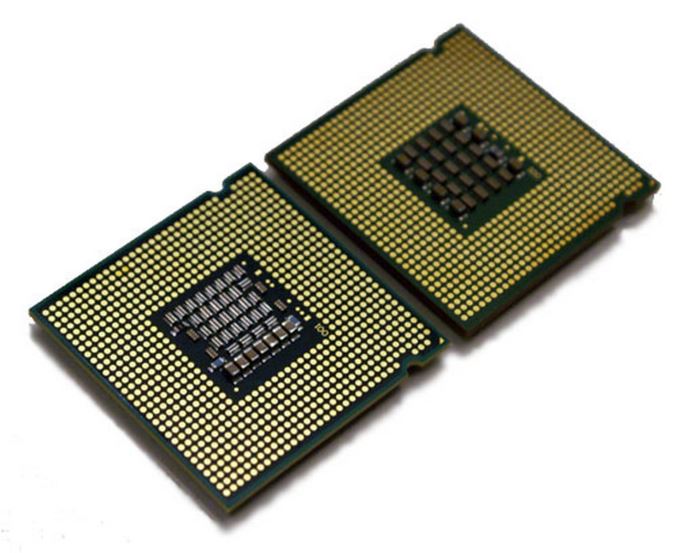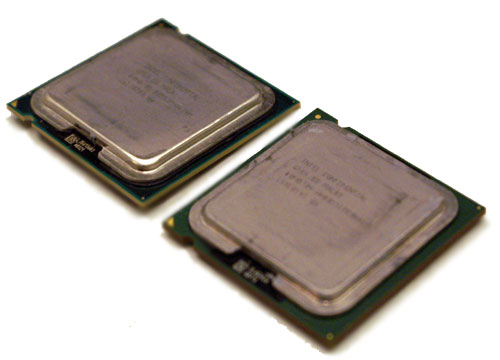Ten Year Anniversary of Core 2 Duo and Conroe: Moore’s Law is Dead, Long Live Moore’s Law
by Ian Cutress on July 27, 2016 10:30 AM EST- Posted in
- CPUs
- Intel
- Core 2 Duo
- Conroe
- ITRS
- Nostalgia
- Time To Upgrade

Today marks a full 10 years since the first Core 2 Duo processors, and hence Intel’s 64-bit Core microarchitecture, were made officially available at retail. These included a number of popular dual-core processor parts, including the seemingly ubiquitous E6400 and the Core 2 Extreme X6800. These were built on Intel’s 65nm process, and marked a turning point in the desktop processor ecosystem. To quote Anand in our launch review: ‘you’re looking at the most impressive piece of silicon the world has ever seen’.
Ten Year Anniversary of Core 2 Duo and Conroe
As part of this piece we will also look at some of the predictions for the future, from the latest (and possibly last) International Technology Roadmap for Semiconductors report, which predicts the stalling of smaller silicon manufacturing nodes over the next 10-15 years.
The first part of this article borrows heavily from Johan’s original look into the Intel Core microarchitecture back in 2006. It’s an awesome read.
Back When I Were A Lad
For a number of our readers, the launch of Conroe was a vast change in the processing landscape. The family of Netburst, Northwood and Prescott processors, in the form of Pentium D and Pentium 4, showed that pursuing the frequency race pushed the silicon far outside its efficiency zone and left a hot, power hungry mess in its wake. It didn’t even come with a muscular V8 sound, and AMD’s Athlon 64 X2 line had taken both the performance and efficiency crown.

Core 2 Duo (left) vs Pentium D (right)
From the perspective of Intel, it had to incorporate a significant paradigm shift in the way it approached the core microarchitecture – no more long pipelines to bump up clock rates to start. The Core microarchitecture design was marketed as a blend of Pentium Pro and Pentium M techniques, as well as the Netburst architecture, however as Johan pointed out at the time, it is significantly Pentium M and it is very hard to find anything Netburst in there. It wasn’t as simple as ‘adding a few functional units or decoders on Yonah and calling it a day’, almost 80% of the architecture and circuit design had to be redone.
As part of this piece, we’re going to take another look at the original architecture improvements of the Core microarchitecture design and some of our old performance metrics from a decade ago.
27th July 2006: Core 2 Launch Day
Ten years ago, Intel launched the following five processors:
| CPU | Clock Speed | L2 Cache |
| Intel Core 2 Extreme X6800 | 2.93GHz | 4MB |
| Intel Core 2 Duo E6700 | 2.66GHz | 4MB |
| Intel Core 2 Duo E6600 | 2.40GHz | 4MB |
| Intel Core 2 Duo E6400 | 2.13GHz | 2MB |
| Intel Core 2 Duo E6300 | 1.86GHz | 2MB |
The X6800 sits at the top with a higher clock speed with a higher supported FSB-to-core ration than previous Intel processors. The Core 2 processors all came from a 143mm2 die, compared the 162mm2 of Pentium D, and they both seem tiny by comparison to the large die sizes we see 2016 for things like the P100. These were chips without integrated graphics either. The introduction of Core 2 pushed the prices of the Pentium D processors down, to give this interesting table:
| CPU | Clock Speed | L2 Cache | Price |
| Intel Core 2 Extreme X6800 | 2.93GHz | 4MB | $999 |
| Intel Core 2 Duo E6700 | 2.66GHz | 4MB | $530 |
| Intel Core 2 Duo E6600 | 2.40GHz | 4MB | $316 |
| Intel Core 2 Duo E6400 | 2.13GHz | 2MB | $224 |
| Intel Core 2 Duo E6300 | 1.86GHz | 2MB | $183 |
| Intel Pentium D 945 | 3.40GHz | 2MBx2 | $163 |
| Intel Pentium D 915 | 2.80GHz | 2MBx2 | $133 |
| Intel Pentium D 820 | 2.80GHz | 1MBx2 | $113 |
| Intel Pentium D 805 | 2.66GHz | 1MBx2 | $93 |
Comparing this to recent Intel processors, and the X8600 matches the list price of the Core i7-5960X (an 8-core part), whereas the popular Core 2 Duo E6400 at $224 at the same price as the Core i5-6600.
A few years ago, I salvaged a super old computer of mine with an E6400 and took it for a spin for a pipeline piece entitled ‘Dragging Core 2 Duo into 2013’. We know that a number of users today are still using the old platform as their day to day machine, and given that it is now celebrating its 10th birthday, it is interesting that anyone wanting to play around with the old hardware can get a motherboard, memory and CPU from eBay for $50-70.
My crusty C2D Setup from 2013











158 Comments
View All Comments
Icehawk - Wednesday, July 27, 2016 - link
I replaced my C2D a couple of years ago only because it needed yet another mobo and PSU and I do like shiny things, I'd bet if it was still around I could pop in my old 660GTX and run most games just fine at 1080. At work there are some C2Ds still kicking around... and a P4 w XP! Of course a lot of larger businesses have legacy gear & apps but it made me chuckle when I saw the P4.With the plateau in needed performance on the average desktop there just isn't much reason to upgrade these days other than video card if you are a gamer. Same thing with phones and tablets - why aren't iPads selling? Everyone got one and doesn't see a need to upgrade! My wife has an original iPad and it works just fine for what she uses it for so why spend $600 on a new one?
zepi - Wednesday, July 27, 2016 - link
You are not mentioning FPGA's and non-volatile memory revolution which could very well be coming soon (not just flash, but x-point and other similar stuff).Personally I see FPGAs as a clear use for all the transistors we might want to give them.
Program stuff, let it run through a compiler-profiler and let it's adaptive cloud trained AI create an optimal "core" for your most performance intensive code. This recipe is then baked together with the executable, which will get programmed near-realtime to the FPGA portion of the SOC you are using. Only to be reprogrammed when you "alt-tab" to another program.
Obviously we'll still need massively parallel "GPU" portion in chip, ASIC-blocks for H265 encode / decode with 8K 120Hz HDR support, encryption / decryption + other similar ASIC usages and 2-6 "XYZlake" CPU's. Rest of the chip will be FPGA with ever more intelligent libraries + compilers + profilers used to determine at software compile time the optimal recipe for the FPGA programming.
Not to mention the paradigm chances that non-volatile fast memory (x-point and future competitors) could bring.
wumpus - Thursday, August 4, 2016 - link
FPGAs are old hat. Granted, it might be nice if they could replace maybe half of their 6T SRAM waste (probably routing definitions, although they might get away with 4T), but certainly the look-up needs to be 6T SRAM. I'd claim that the non-volitile revolution happened in FPGAs (mainly off chip) at least 10 years ago.But at least they can take advantage of the new processes. So don't count them out.
lakerssuperman - Wednesday, July 27, 2016 - link
I'm reading this from my old Sony laptop with a Core 2 Duo and Nvidia GPU in it. With an SSD added in, the basic task performance is virtually indistinguishable from my other computers with much newer and more powerful CPU's. Granted it can get loud when under load, but the Core 2 era was still a ways away from the new mobile focused Intel we have now.I guess my basic point is that I got this laptop in 2009 and for regular browsing tasks etc, it is still more than adequate which is a testament to both the quality and longevity of the Core 2 family, but where we are with CPU power in general. Good stuff.
jeffry - Monday, August 1, 2016 - link
I agree. Got me a Sony SZ1m in 2007 (i think?), flip switched the core duo yonah with a core2duo T7200 merom. Because its 64 bit and now i can run 64 bit os and 64 bit software on it.boozed - Wednesday, July 27, 2016 - link
Funny to think that despite four process shrinks, there's been minimal power and clock improvement since then.UtilityMax - Wednesday, July 27, 2016 - link
To some of you it may sound like a surprise, but a Core2Duo desktop can still be fairly usable as a media consumption device running Windows 10. I am friends with a couple who are financially struggling graduate students. The other way, they brought an ancient Gateway PC with LCD from work, and they were wondering if they could rebuild it into a PC for their kid. The specs were 2GB of memory and Pentium E2180 CPU. I found inside of a box of ancient computer parts which I never throw away an old Radeon graphics card and a 802.11n USB adapter. I told them to buy a Core2Duo E4500 processor online because it cost just E4500. After installing Windows 10, the PC runs fairly smoothly. Good enough for web browsing and video streaming. I could even load some older games like Quake 3 and UrbanTerror 4.2 and play them with no glitch.UtilityMax - Wednesday, July 27, 2016 - link
I mean, the E4500 cost just 5 bucks..DonMiguel85 - Wednesday, July 27, 2016 - link
Still using a Core 2 Quad 9550. It bottlenecks most modern games with my GTX 960, but can still run DOOM at 60FPS.metayoshi - Wednesday, July 27, 2016 - link
Wow. Actually, just last holiday season, I replaced my parents' old P4 system (with 512 MB RAM! and 250 GB SATA Maxtor HDD!) with my old Core i7-860 since I upgraded to a system with a Core i7-4790K that I got on a black friday sale. The old 860 could definitely still run well for everyday tasks and even gaming, so it was more than good enough for my parents, but the video processing capabilities of the more recent chips are a lot better, which is the main reason I updated. Also, the single threaded performance was amazing for the 4790K, and the Dolphin emulator did not run so well on my 860, so there was that.Speaking of Core 2, though, I owned an ASUS UL30Vt with the Core 2 Duo SU7300 CPU and an Nvidia GeForce G 210M. While the weak GPU was not so great for high end gaming, the overall laptop was amazing. It was more than powerful enough for everyday tasks, and had amazing battery life. It was pretty much what every ultrabook today desires to be: sleek, slim, but powerful enough with great battery life. That laptop to me was the highlight of the Core 2 era. I was kind of sad to let it go when I upgraded to a more powerful laptop with an Ivy Bridge CPU and 640M LE GPU. I don't think any laptop I owned gave me as much satisfaction as that old Asus. Good times.